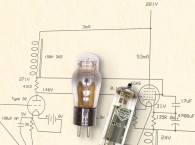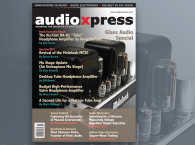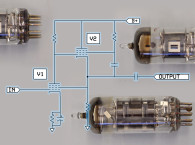
The 10W, 0.9% distortion single-ended (SE) amp is the lowest distortion amplifier I have come across. It also has lower distortion than published tube manual push-pull amps.
The damping of the 10W amp is incredible: 2.8V across an 8Ω resistor increases to only 3.8V when the 8Ω load is removed. This is accomplished in a standard output circuit without the aid of negative feedback. It is obvious new design ideals for vacuum tubes are still with us. Behold! The magic of paralleling and low mu tubes.
Note: If operating in the 10W SE Stereo mode, you need to add two Hammond output transformers (P-T1640SE, $93 each) to the cost.
The Choice Is Yours
The eleven-tube amplifier (Photo 1) uses very linear low mu, high perveance 12B4s, and a 12AT7 preamp. Five paralleled 12B4s are used in each channel of the stereo line amp (Fig. 1). In the line amplifier mode only the 12B4s are used.
In the headphone/power amplifier/preamp mode, the 12AT7 drives the 12B4s. The line amp and multi-mode amp do not employ negative feedback. The line amplifier frequency response is flat from 10Hz to 50kHz, distortion is less than 0.15% at 2V RMS output, and output impedance is 420Ω. The voltage gain of the 12AT7 and five paralleled 12B4s is 125.

Note: The gain of a single 12B4 is 2.4 and five paralleled 12B4s have a gain of 3.8 (cathode un-bypassed) and a gain of 5.6 (cathode bypassed). The plate current requirement of the five 12B4As is 50mA when using a plate load resistor of 3.1kΩ.
The selection of the low mu 12B4 enables this line amp to rival or surpass the performance of the most expensive commercial line amps because they use medium mu triodes. For truly superlative sonic performance a line amp requires a low mu, high linearity, high perveance tube, and the 12B4 meets this requirement.
I know of no other tube more suitable for this application. The amp is designed to outperform $3k to $10k commercial line amplifiers.
General Information
Great care is required when operating tubes in a parallel configuration to prevent oscillation or instability. To address this problem most resistors in the amp are carbon composition. The 3.1kΩ, 10W plate load metal-oxide resistors have 2Ω carbon composition resistors in series with the plate load resistors. The cathode resistors are 220Ω, 5W metal-oxide types.
The construction of the amp requires short leads as used in R-F circuits, and an aluminum chassis is mandatory to ensure good grounding. A ground lug between tubes 1-5 ensures short leads for the cathode resistors. The “plate stopper” 2Ω resistors are connected to a terminal strip located between tubes 2 and 3.
Single 2Ω resistors are connected to the plates of tubes 2 and 3, and two seriesconnected 2Ω resistors are connected to plates of tubes 1 and 5, respectively. This ensures a carbon block exists on the long lead required to connect tubes 1 and 5 to the terminal strip and the metal-oxide plate resistors.
Figure 1 shows that much thought was given to ensure the stability of the paralleled 12B4s. The pin configuration of the 12B4 grid with pins 2 and 7 connected to the grid ensured a short path for the insertion of a “grid stopper” resistor between tube stages. Pins 1 and 9 of the tube sockets face toward the middle of the chassis ensuring short runs for the cathode, plate, and grid resistors. It is important that you do not substitute other types of resistors for the carbon composition resistors. These recommendations are required to ensure stability when using parallel tube circuits.

Headphone
Application: The headphone amplifier circuit uses a 12AT7 to obtain sufficient audio output signal to drive the five paralleled 12B4s line amp. A 0.25V RMS input signal to the 12AT7 provides an output of 9V RMS from the 12AT7-output circuit to drive the headphone 12B4s amp (maximum output). The output for the headphones is obtained from the cathodes of the five paralleled 12B4s.
You operate the headphones by simply plugging the headphone jack into the chassis mounted ¼˝ or 3.5mm jack. For best performance, a 55Ω-75Ω impedance headphone is required.
The amp has a distortion of 0.4% at 1kHz when using a 65Ω headphone with a measured output signal of 0.8V RMS. At a normal output level of 0.6V RMS, distortion is 0.15%. The 0.6V and 0.8V RMS signals provide a very loud listening level. The frequency
response is flat from 20Hz-50kHz.
The distortion and frequency response measurements are made at the coil of the headphone.
Switch Settings:
1. Set S2 to H.P. position.
2. Set S3 to L.A. position.
Preamp
Application (Optional): You may choose the preamp mode if you prefer to build a power amp that uses only a single amplifying stage to drive a SE power output tube or a phase inverter stage to drive push-pull power output tubes. The preamp mode is the same as the headset mode except the output signal is obtained from the plates of the 12B4s via the 0.47μF capacitor. If you require direct DC coupling of the phase inverter, add a separate pair of RCA female jacks.
The +115V DC output from the 12B4s (3.1kΩ) plate load resistor is compatible with the DC grid voltage requirements of most direct-coupled phase inverters.
The voltage gain of the 12AT7 and 12B4s is 125 with cathodes of the 12B4s un-bypassed and 185 with cathodes bypassed. The distortion at 10V RMS output is 0.4% at 32Hz, 0.34% at
1kHz, and 0.6% at 20kHz with 12B4s cathodes un-bypassed. The distortion at 30V RMS output is 1.2% at 32Hz, 0.65% at 1kHz, and 1.5% at 20kHz with cathodes bypassed.
The frequency response is flat from 20Hz-25kHz.
Switch Settings:
1. Set S2 to H.P. position for a voltage gain of 125 or to P.A. position for a voltage gain of 185.
2. Set S3 to L.A. position.
Power Amp
Application (Optional): To operate in the power amp mode, set the DPDT switch (S3) from the line amp mode to the power amp mode and the DPDT switch (S2) to place the negative end of the 1000μF capacitor at ground. The S3 switch setting connects the 3.1kΩ resistor from the plate circuit of the 12B4s to the 1200Ω 25W Hammond output transformer of the SE-12B4s. The power output of the SE 12B4s is 10W, and the distortion at this level is 0.9% with no loop feedback. The frequency response is flat from 30Hz to 15kHz at 10W output level. A 0.7V RMS input voltage is required for 10W output from the power amp.
The plate current of the five 12B4s in each stereo channel is 148mA. The damping criterion of the amplifier is excellent. At 10W without feedback, the distortion at 32Hz is 2.0%, at 50Hz it is 1.2%, and is 0.9% at 1kHz, 1.6% at 5kHz, and 2.2% at 15kHz, respectively.
At 5W the distortion is 0.8% at 32Hz, at 50Hz it is 0.7%, and 0.6% at 1kHz, 1.5% at 5kHz, and 1.8% at 15kHz, respectively. These specifications are outstanding for a single-ended amp, especially when operating with a low plate voltage of 260V DC.
Switch Settings:
1. Set S2 to P.A. position.
2. Set S3 to P.A. position.
Note: A separate volume control is provided for R and L channels to prevent crosstalk. Switch S1 (Fig. 2) turns the heater supply on and off, and switch S2 turns the high voltage supply on and off.
The H.V. switch S2 only operates if the heater switch is set to the on position.
Of Interest: The right and left channel amps are connected in a monaural configuration by adding audio interstage transformer A.E.- P-T124B (10K to 90K C.T.) to the input of the amp and P-P, 120W, 1900 C.T. (A.E.-P-T1650T) to the output of the right and left channels.
No changes are made to the 11-tube amp. The power output of the monaural amp is 24.5W, and the distortion at 1kHz measures 1.2%. A large percentage of the distortion is attributed to the input transformer. The frequency response is relatively flat from 20Hz to 15kHz. Sensitivity is 0.56V RMS for 24.5W with 33kΩ resistors connected across the secondary windings of the interstage transformer. I do not recommend this amp for use as a monaural amplifier, but I thought the information here might be interesting. The 35W/60W amp presented in aX June 2004 is more cost effective and a more desirable choice.


Power Supply
The power supply (Fig. 2) contains a DC heater supply and a high voltage plate supply. The DC heater supply uses a 12V AC, 6A transformer connected to a 25A full-wave bridge rectifier. The output of the rectifier is connected to a 4700μF capacitor, and the filtered output voltage from the capacitor is connected to the heaters of the 12B4s and 12AT7. The ripple voltage of the supply is 0.9V RMS.
The high voltage plate supply uses a 100 VA line transformer with the output secondary winding wired for 230V RMS.
This output voltage connects to a fullwave bridge, and the 260V DC output from the bridge is connected to a 470μF capacitor and a 1.0H 300mA choke. The output of the choke is connected to a 470μF capacitor, and is additionally filtered by a 2H choke and a 470μF capacitor connected to the 12AT7 plate circuit. The ripple voltage of the 260V DC supply is 0.3V RMS. The bleeder of the power supply is 100kΩ, 2W.

Construction
The amplifier I originally built as a line amp on a 13.5 × 5 × 2˝ chassis is shown in Photo 1. The chassis was very crowded (wiring) and required mounting the heater transformer on the rear of the chassis.
To avoid the crowding and to mount the heater transformer on the underside of the chassis and the two 25W output transformers on the top of the chassis, I recommend that you use a 16 × 8 × 3˝ chassis for this project. Mount the power transformer at the end-middle of the chassis. Locate the two output transformers in the middle of the chassis in line with the power transformer, and position the five right-channel 12B4s and five leftchannel 12B4s on either side of the 25W output transformer.
Connect the four electrolytic capacitors in the power supply to terminal strips on the underside of the chassis. Mount the fan facing the power transformer and notch out the bottom of the chassis to enable the fan to cool the electrical components on the underside of the chassis.
Conclusion
I believe this amplifying device is the most versatile and outstanding in technical specifications for each of its four operating modes of any device currently offered to the audiophile. The headphone and 10W SE amp modes are especially ideal for apartment dwellers. If you elect to build this amp, you will enjoy many hours of listening entertainment. aX
WARNING: Dangerous voltages are present, exercise extreme caution when working on the line amp and never leave the line amp upside down when children are present.

Additional Notes.
Letters to the author
1.
Could Mr. Still clarify his schematic for the Versatile Line Amp (aX, May ’07, p. 21) only with no headphone output nor 12AT7 tube nor output transformers? Is T2 the correct triad number? Mouser’s description appears to be a single 115V secondary transformer in my catalog. It appears to me that in the power supply both DC outputs will be higher than 12V and 260V. Am I missing something here?
G. Max Carter - Woodland Park, Colo.
Response from Joseph Norwood Still:
The 12V DC and 260V DC are the output voltages obtained from the power supply. These output voltages are correct.
The triad power transformer T2 (553-N77U) is reversed; the primary is operated as the secondary with the two 120V AC windings connected in series. The secondary of T2 is, of course, operated as the primary. To limit the multimode amplifier to line amplifier use, delete all parts associated with power amp and headphone amp operation.
This will simplify construction of the line amplifier.
Tube socket P-ST9-137R is no longer available.
I suggest replacing with ceramic 7/8˝ diameter P-ST9-511 ($1.95) from Antique Electronic Supply.
2.
I do not understand the function switch S2a in Joseph Norwood Still’s versatile line amp article. In one position it looks as though all audio is shunted to ground before it ever gets to the 12B4 tubes. Also, in the other position switch S2a shorts out all of the headphone signal, but this may allow more cathode current to flow for the power amp function. Maybe the switch is somehow misdrawn.
I noticed that the 12B4 tubes are not allowed to draw equal current. I say that because it looks as though they are not all sharing the same current in plate and cathode circuits because the diagram shows some plates and cathodes go through two and some tubes go through one resistor in both plate and cathode circuits.
I am wondering whether I’m missing something.
James Gilmore
Response from Joseph N. Still:
You are correct, the drawing I submitted to audioXpress had an error pertaining to switch S2A. Switch S2 has a wire corrected from the H.P. position to the 220N capacitor (C3). This wire must be eliminated from the circuit and all is well.
The corrected circuit is shown in Fig. 1. The second part of your question concerned unequal value of resistance between 12B4 stages. These resistors are used as carbon blocks to prepare oscillation. The small values of these cathode and plate resistors (2Ω) have no effect on currents of the 12B4s. Thus no unequal electrical balance problems are produced.





